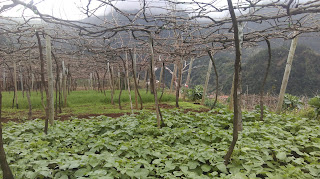 |
| Jura wines boast their region in raised glass on the bottle. |
Sure some of these wines can be funky and earthy with intense acidity, and sometimes the whites show nutty and oxidized elements (depending on the producer and style). But I’m convinced Jura wines (sparkling, white and red) offer the wine newcomer an intellectually-fascinating and palate-expanding experience, but also a damn pleasurable one. When it comes to unique wines with quirky personalities and complex flavors, Jura wines are quintessential.
The prices are right, that’s for sure. There are so many Jura wines that you can find in the $20-$25 range. As with any wine region, sure, you can spend more. But entry-level Jura wines are so much fun, and even the age-worthy wines frequently show well upon release.
I recently tasted through a bunch of Jura wines at my favorite wine shop, Weygandt Wines in DC's Cleveland Park neighborhood. They've been importing a range of Jura wines for a while, and they're always on the lookout for new and exciting producers.
If you're looking for a unique and interesting wine, you can't do much better with $20-$30.
My notes:
N.V. Domaine Désiré Petit Crémant du Jura - France, Jura, Crémant du Jura
$21
Lots of spice and nutty elements on the nose. Creamy, spiced apple on the palate but so zesty. Flavors of toasted bread crumbs over oyster shells. Lots of fun, unique flavors. 100% Chardonnay. (88 points)
N.V. Domaine Désiré Petit Crémant du Jura - France, Jura, Crémant du Jura
$21
Zesty aromas of roses, baby’s breath and strawberries. Crisp and spicy on the palate, full of strawberries and white peach, accented by notes of white tea and spice. Very good for under $20. 100% Pinot Noir. (87 points)
2011 Les Granges Paquenesses Côtes du Jura La Mamette - France, Jura, Côtes du Jura
$23
This is getting better and better with age. Lots of minerals and stones with some salted almond accents to the melon and orange fruit. I’m impressed by the depth and complexity this is gaining but it’s still so fresh and vibrant. (89 points)
2014 Domaine Didier Grappe Chardonnay Côtes du Jura Novelin - France, Jura, Côtes du Jura
$25
So bright and clean, with flowers, sea spray and clean laundry on the nose. Creamy palate but so tangy and salty with a brightness that tingles onto the finish. (87 points)
2014 Les Granges Paquenesses Côtes du Jura La Pierre - France, Jura, Côtes du Jura
$28
Non-oxidized style, this is a fresh, bright and salty wine with a lovely creaminess as well. Zesty but nervy, tons of mineral complexity, along with notes of honeycomb and white tea. Lovely stuff. (90 points)
2013 Caveau de Bacchus Melon à Queue Rouge Aviet - France, Jura, Arbois
$35
Smells peachy and clean with orange rind and lime juice. Rich but crunchy and salty on the palate. Lime and orange peels mixed with crunchy sea salt and hints of white pepper. Bright, long finish. Really interesting stuff – I’d love to cellar some for a few years and see what comes out. (90 points)
2014 Domaine Désiré Petit Arbois - France, Jura, Arbois
$21
I love the fresh aromatics of Trousseau, and this one is so perfumed: black tea, roses, spiced red berry compote. Crisp and juicy on the palate with red cherries and red apple peel. Clean and soft tannins with fresh acid. Salty and spicy on the finish. So good for the money. (89 points)
2011 Domaine de la Pinte Pinot Noir Arbois - France, Jura, Arbois
$30
Fresh, vibrant and floral aromatics, fresh raspberries and cherries. Silky but structured with fine, dusty tannins and, of course, bright, refreshing acid. Tart cherries and wild strawberries mix with black tea, bay leaf and pepper. Vibrant and open now but I’m interested to see what develops in the next two to four years. (90 points)
2014 Domaine Didier Grappe Côtes du Jura Insouciantes - France, Jura, Côtes du Jura
$30
Very interesting aromatics here: wild cherries, red apple, grapefruit, and a host of spice and nut elements. Great acid, fine tannins, the crunchy red berries are laced with spices and herbs. That acidity is rocking and this wine is pure and vibrant. Trousseau, Ploussard and Pinot blend. (90 points)















